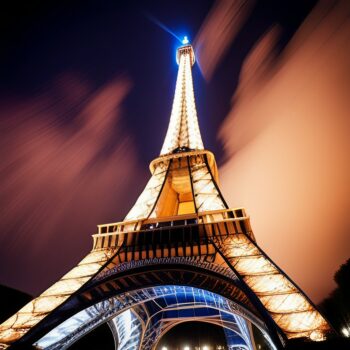When one thinks of Paris, an iconic silhouette rises above the city’s skyline—the Eiffel Tower. But beyond its status as a symbol of romance and elegance, lies a rich history that spans centuries and involves engineering triumphs, artistic controversies, and unexpected turns. In this blog post, we delve into the captivating journey that led to the creation of the Eiffel Tower.
🏗️ Dreams and Design: Gustave Eiffel’s Vision
The Eiffel Tower’s origins trace back to the late 19th century when Paris was preparing to host the 1889 World’s Fair, known as the Exposition Universelle. Engineer Gustave Eiffel, renowned for his innovative iron structures, conceived the idea of a towering iron monument that would showcase the technical prowess of the era.
📝 A Monument of Controversy: The Design Challenge
Gustave Eiffel’s design for the tower, featuring an intricate lattice of iron beams, initially faced skepticism and even outright opposition. Some prominent artists and architects of the time signed a petition against the “useless and monstrous” tower. Yet, Eiffel’s vision prevailed, and construction began in 1887.
🏆 A Triumph of Engineering: Construction and Assembly
The construction of the Eiffel Tower was an engineering marvel of its time. The tower’s iron components were prefabricated and then assembled on-site with incredible precision. Over 18,000 iron parts were connected by over 2.5 million rivets. The tower’s 324-meter height was an astonishing feat, making it the tallest man-made structure at the time.
🎉 A Grand Unveiling: The 1889 World’s Fair
The Eiffel Tower made its grand debut at the 1889 World’s Fair, a celebration of technological and cultural advancements. As visitors ascended its heights, they were treated to panoramic views of Paris, forever linking the tower to the city’s identity. Despite initial criticisms, the tower quickly became a symbol of French innovation and progress.
🗼 Through Wars and Time: The Tower’s Evolution
As the 20th century unfolded, the Eiffel Tower witnessed a series of transformations. During World War I, it served as a radio transmission station. In World War II, it played a role in resisting German forces. Over the years, it has been repainted numerous times and illuminated with dazzling lights for special occasions.
🎨 A Canvas of Creativity: The Eiffel Tower in Art and Culture
The Eiffel Tower’s influence extends beyond architecture—it has inspired countless artists, writers, and filmmakers. From paintings by renowned artists to romantic movie scenes set against its backdrop, the tower’s allure continues to captivate the imagination.
💍 A Symbol of Love and Romance
The Eiffel Tower’s connection to love and romance was solidified by countless couples who have chosen its heights as a backdrop for proposals, weddings, and declarations of affection. It has become a destination for lovers from around the world, adding a layer of sentiment to its historical significance.
🌍 A Timeless Legacy
Today, the Eiffel Tower stands as not only an architectural masterpiece but a testament to human ingenuity and endurance. Its enduring popularity and cultural significance make it a vital thread in the tapestry of Parisian identity and a beacon of inspiration for dreamers and adventurers alike.
As we gaze upon its elegant lattice, let us remember that the Eiffel Tower is not merely an emblem of Paris—it’s a reflection of the passion, creativity, and determination that shape the course of human history.




Synergistically exploit equity invested e-business vis-a-vis low-risk high-yield scenarios. Conveniently impact cutting-edge.
Intrinsicly recaptiualize plug-and-play alignments without competitive architectures. Collaboratively impact wireless outsourcing whereas holistic e-tailers. Authoritatively visualize interdependent relationships and.